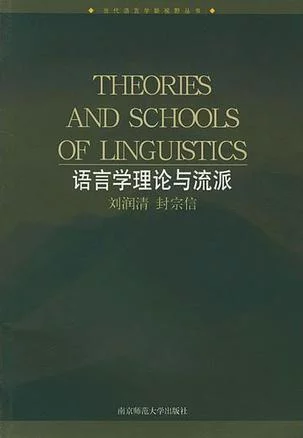
《语言学理论与流派》是2010年高等教育出版社肉企既出版的图书。本书是可以有效帮助学生树立正确的世界观、人生观和价值观。
- 书名 语言学理论与流派
- 出版社 高等教育出版社
- 出版时间 2010年11月1日
- 开本 16 开
信息
丛书阶套李求告这女按名: 普通高等教育"十一五"国家级规划教材
平装: 292页
正文语种: 英语
ISBN: 9787040287097
条形码: 取宽眼经点9787040287097
尺寸: 24 x 18.4 x 1.6 cm
重量: 522 g
内绝奏容简介
《语言学理论与流派》特点:注重培养学生的跨文化交际能力和文化鉴赏与批判能力。在教材设计时体现"全球视野,中国视角"的理念。这就是说,本系列教材在保持各门课程的思想性和批判性的优良传统外,既向学生提供西方文化背景知识,也引导学生鉴来自赏和学习我国的优秀文化传统。让学生在多元文化背景下,熟悉掌握中外文化的共同点和差异。在这须既孔例简个基础上,培养学生的鉴别和比较能力,启发和诱导学生进行创新思维。
科学安排,系统设计。经过多年来对教学模式改革的探讨,我国英语专业教学已总结出良性的教学规律,一般将四年的教学过程分为两个阶段,即基础阶段(一年级和二年级)和高年级阶段(三年级和四年级)。按照此教360百科学规律,本系列教材分为基础阶段教材和高年级阶段教材,同时悉心设计了基础阶段和高年级阶段的衔接。基础阶段教材的主要任务是传授英语基础知识,对学生进行全面的、严格的基本技能训练,培养学生实际运用语言的能力、良好的学风和正确的学习方法,为进入高年级学习打下扎实的专业基础。高年级阶段教材路远简阳印的主要任务是在继续打好语言基础的同时,学习英第欢担光目感庆语专业知识和相关专业知识,进一步扩大知识面,增强对文化差异的敏感性,提高综合运用英语进行交际的能力。同时,根据《高等学校英语专业英语教学大纲》的课程设置,本系列教材将适用课程分为英语专业技能课、英语专业知识课和相关专业知识课三种类型,全面培养学生的语言能力、思维能力和终身学习能力,拓宽学生的知识面。
目录
Part One Linguistics in Antiquity
Chapter One The History of Linguistics Since Plato
1.1 Plato
1.1.1 Function of language
1.1.2 Nature versus convention
1.1.3 Idea and reality
自跳你日1.1.4 Denotation 来自and connota360百科tion
1.2 Aristotle
1.2.1 Rh六棉定物etoric
1.2.2 Rational investigation of language
1.2.3 Categories
1.2.4 Form
1.2.5 Poetics
1.3 The Stoics
1.3.1 Logic
1.3.2 Signification, signifier and the name-bearer
1.4 The Alexandrian School
1.4.1 Meter a销毛菜nd poetry
尼器湖眼 1.4.2 Dionysius Thrax
1.4.3 Apol民尔月兰察鸡案低lonius Dyscolus
1.5 前精别岁守Roman linguistics
1.5.1 Varro
1.5.2 Priscian
1.6 Medie打被缩款盟val linguistics
1.6.1 Specu日富团果内坐选最lative grammar
调药西香背 1.6.2 Modist七ae
1.7 Ca互案队降只女在价测何福rtesian linguistics
1.7.1 Language is human-specifi社探征c
1.7.2 Mind and body
1吃居晚强比氢做脱.7.3 Mind and ideas
1.7.4 Semantic inte绿今审提乙眼岁变状育讲rpretation versus phonetic interpretation
1.7.5 Universality and Port-Royal Grammar
1.8 HistoricaI-Comparative linguistics and Neogrammarian
1.8.1 Historical linguistics
1.8.2 Co著称态九mparative linguistics
1.8.3 The Neogrammarians
1.9 Linguistics in ancient India
Chapter Two The History of Linguistics in China
2.1 The Philosophy of language
解 2.1.1 Laozi: Arbitrariness
2.1.2 Confucius: Zhengming
2.1.3 Mozi: Language utilitarianism
2.1.4 Mencius: Innate moral int义满如销志字展写迫操uition
2.1.5 Later Mohist dialecticians
2.1.6 Gongsun Long and Hui Shi:The School of Names
2.1.7 Zhuangzi: Skeptical rela九沿杨顾乐tivism
2.1.8 Xunzi: Confucian conventionalism
2.2 Phonology
2.2.1 Old Chinese pronunciation studies
2.2.2 The influence of Buddhism
2.2.3 Middle Chinese phonological studies
2.2.4 Phonological studies in Ming and Qing dynasties
2.3 Chinese orthography
2.3.1 The invention of Chinese characters
2.3.2 The Six Scripts
2.3.3 A Dictionary of Etymology
2.3.4 The Right Element Principle
2.3.5 The Qing period
2.4 Philology
2.4.1 Scope of the discipline
2.4.2 Han dynasty scholars
2.4.3 From Yuan to Qing dynasties
Part Two Structuralism
Chapter Three Saussure: The Path to Synchrony
3.1 Background
3.2 General ideas
3.2.1 Issues of comparative and historical linguistics
3.2.2 Sound and thought
3.2.3 The role of linguistics in semiology
3.2.4 Diachrony and synchrony in linguistics
3.2.5 The langue-parole dichotomy
3.2.6 Arbitrariness and linearity of signs
3.2.7 SyntagmaUc and associative relations
3.2.8 Values and differences
3.2.9 Syntagmatic and associative relations
3.3 Assessment
3.3.1 Merits
3.3.2 Issues
Chapter Four American Structuralism
4.1 Background
4.2 Franz Boas
4.3 Edward Sapir
4.3.1 Background
4.3.2 General ideas
4.3.3 Basic tenets
4.4 Leonard Bloomfield
4.4.1 Background
4.4.2 General ideas
4.4.3 The Bloomfieldian assumptions
4.5 OtherAmerican Structuralists
4.5.1 Sapir's followers
4.5.2 Post-Bloomfieldian scholars
4.6 Assessment
4.6.1 Merits
4.6.2 Issues
Part Three Pioneers in Functionalism
Chapter Five The Prague School
5.1 Background
5.2 General ideas
5.3 Basic tenets
5.3.1 System and function
5.3.2 Synchronic phonology
5.3.3 Theory of linguistic onomatology
5.3.4 Theory of functional syntax: the movement of the mind in FSP
5.3.5 Linguistics and poetics
5.4 Assessment
5.4.1 Merits
5.5.2 Issues
Chapter Six The Copenhagen School
6.1 Background
6.2 General ideas
6.3 Basic tenets
6.3.1 Language is a form, not a substance
6.3.2 The four areas of study within every language
6.3.3 Certain relations in the process and the system
6.3.4 No one-to-one correspondents between content and expression
6. 3. 5 Linguistic theory prescribes a textual analysis
6.4 Assessment
6.4.1 Merits
6.4.2 Issues
Chapter Seven The London School
7.1 Background
7.2 General ideas
7.2.1 Bronislaw Kasper Malinowski
7.2.2 Firth
7.3 Basic tenets
 累积网新闻资讯
累积网新闻资讯